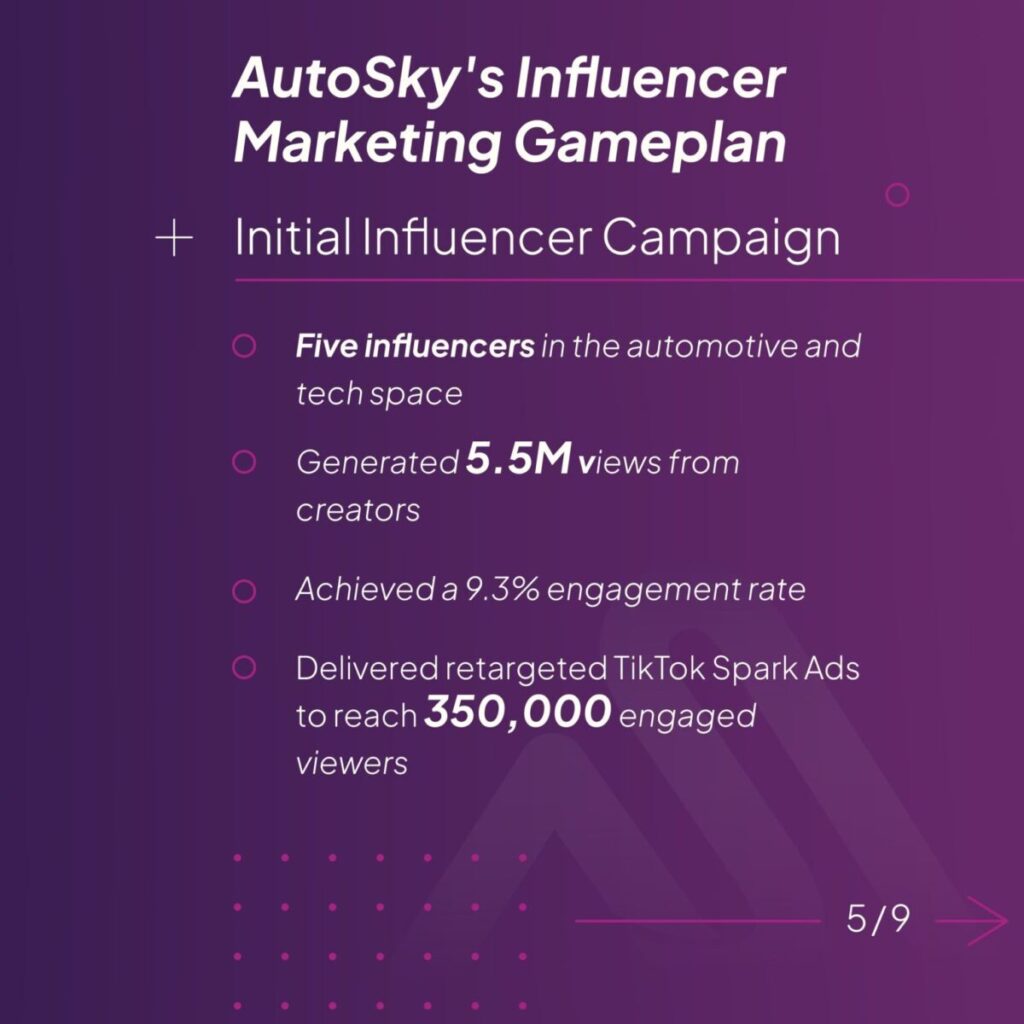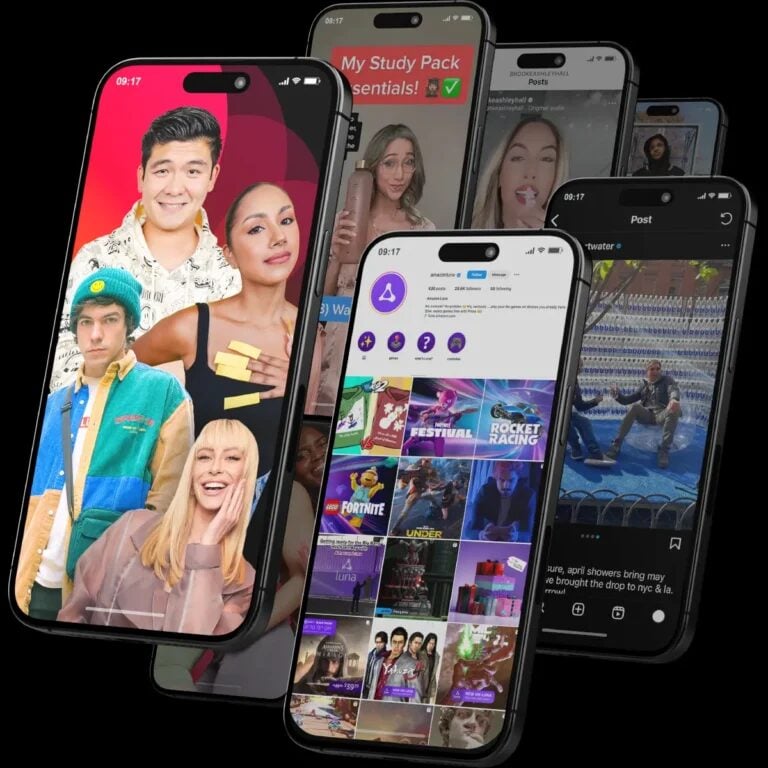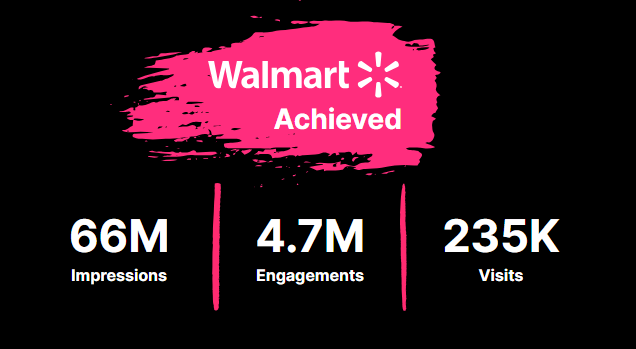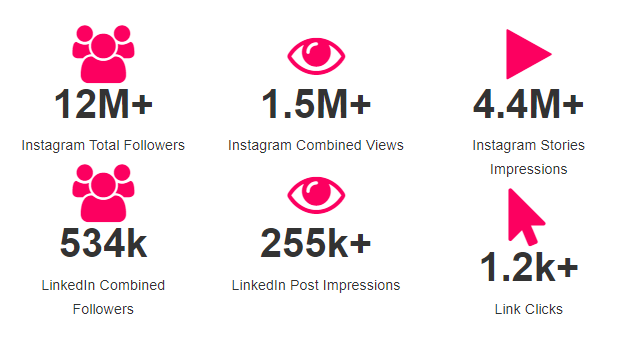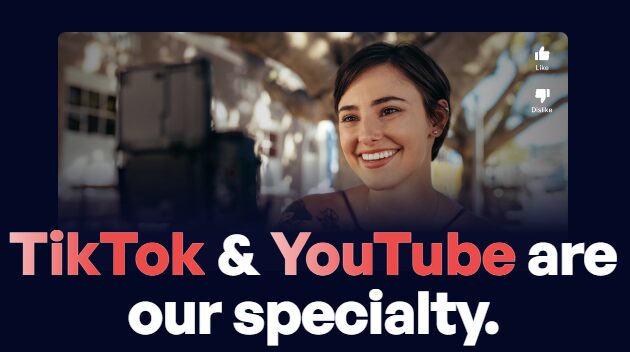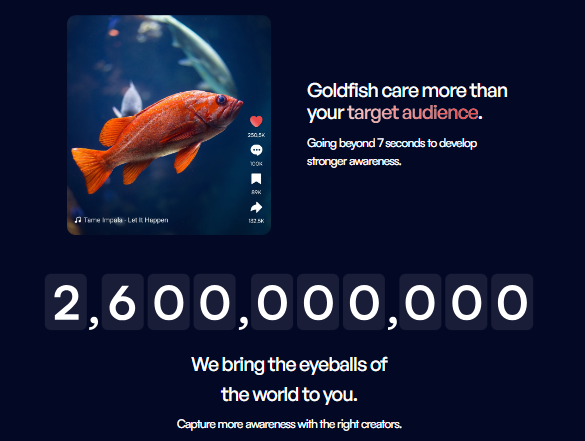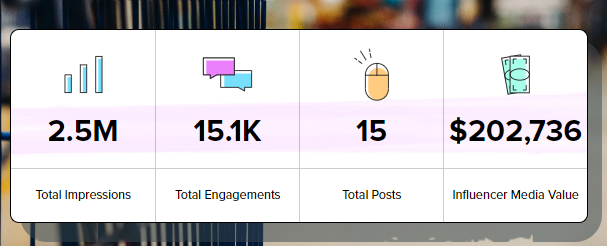Top Influencer Marketing Agencies in 2025
Influencer Marketing Hub sets itself apart from conventional review platforms through the involvement of Influencer Marketing experts such as Werner Geyser, Djanan Kasumovic, Camille Kennedy, Dave Eagle, and other notable industry figures. This expert team brings a profound understanding of the Influencer Marketing landscape, assessing tools and platforms with an insider’s perspective on capabilities, experience, and industry acumen. Unlike user-generated review platforms, Influencer Marketing Hub’s evaluations are rooted in extensive firsthand experience and direct interactions with the tools and platforms in question. This ensures that the reviews are not only trustworthy but also deeply informed. High-caliber brands like Ubiquitous, The Shelf, and Viral Nation undergo rigorous monthly evaluations, highlighting the platform’s commitment to identifying and showcasing top-tier solutions in Influencer Marketing and beyond.
Influencer Marketing Hub has consistently been recognized by leading media outlets for our authoritative data, findings, and insights within the Influencer Marketing landscape. Our platform is frequently cited as a trusted source of information, demonstrating the value and impact of our work in shaping industry standards and practices.
Influencer Marketing Hub employs an expert-driven methodology to evaluate Influencer Marketing agencies, ensuring that our recommendations are both reliable and comprehensive. This approach is designed to help businesses and individuals find the best agencies to meet their specific Influencer Marketing needs. Here’s how we assess the various agencies like Ubiquitous, The Shelf, and Viral Nation:
For nearly a decade Influencer Marketing Hub has guided brands to make informed decision on selecting influencer marketing services. Influencer marketing agencies act as the experts in a field where brands often lack in-house resources to drive positive ROI. They handle everything from discovering the right influencers, negotiating contracts, managing campaigns, and campaign optimization.
According to our latest survey, brands are projected to increase their budgets for influencer marketing to 45.8% in 2024, compared to last year.
In fact, the compound annual growth rate (CAGR) for influencer marketing is estimated to be 32.50% between 2022 and 2029, taking the industry to a valuation of $69.92 Billion by 2029.
The success of influencer marketing relies heavily on collaborating with the right influencers and managing the campaigns effectively. For a brand working with hundreds of influencers, it can become increasingly challenging to handle the logistics and measurement of each campaign.
In the past few years, their roles have evolved and become even more instrumental due to the wide array of platforms and marketing techniques. While we can't include every agency out there, here are the top influencer marketing agencies to look out for in 2025 globally and if you are based in USA feel free to visit our local recommendations:
Leading Influencer Marketing Agencies:
1. Ubiquitous

Location(s): Ubiquitous is based out of one location in Los Angeles.
As the name gives way, Ubiquitous is an influencer marketing agency whose motto is to make your brand “a household name.”
The agency works with some of the most common brands across the world, including Netflix, Lyft, Doritos, Samsung, and Target.
Ubiquitous clients
Sarah Minami, the spokesperson for Disney, praises the agency, saying,
“I worked with Ubiquitous on an influencer campaign, and it was the best experience I’ve had in the space! Great communication, as well. If I could give more than 5 stars, I would!”
Ubiquitous advertises itself as Hinge but for creators and businesses. The agency specializes in three platforms: TikTok, Instagram, and YouTube.
Possibly the best part about working with Ubiquitous is that the agency makes influencer marketing simple. It does so by handling all touchpoints of your campaign, from content creation and influencer outreach to deploying ad spend.
Key Services
Starting with TikTok, Ubiquitous has more than 10,000 influencers in its Rolodex. The cumulative follower count of these creators is over 27 billion, giving brands an opportunity to reach a massive audience.
Ubiquitous platform specialization
Ubiquitous doesn’t only stop at finding brands suitable TikTok influencers. Its in-house marketing team also works with companies to develop TikTok-specific campaigns and set a strategy that drives results.
Aly Treuhaft, a digital marketing expert at Triller, says,
“Putting money into TikTok is complex, time-consuming, and requires countless hours of coordination and effort, but the Ubiquitous team simplifies the process and executes with excellence.”
The agency also has a similar approach to Instagram. While the in-house marketing team creates a testing roadmap for your campaign and chooses the best-fit influencers, you can focus on other important aspects of running your business.
Instagram analytics
On YouTube, the agency has a network of over 2,000 creators in different fields. Together, these creators have 4 billion followers, and their videos have been viewed billions of times.
Success Stories
The three platforms that Ubiquitous specializes in have unique success stories, showcasing the agency’s capabilities and expertise in different niches. Wienerschnitzel, the world’s largest hot dog food chain, previously relied on traditional marketing, such as TV commercials, to reach its target audience.
However, with the digital media landscape changing, the company wanted to explore TikTok. When the agency took over, the company’s TikTok page only had 50 followers.
Wienerschnitzel case study phases
Ubiquitous engaged influencers in the comedy, couples, lifestyle, and food niches to create content around going to Wienerschnitzel to manifest the exposure effect and generate short-form video content for the brand.
Influencers were selected based on their audience size, previous use of Spark Ads, and their ability to create relatable, engaging content. Allowing creators full creative freedom led to captivating content, highlighted by standout examples such as Harry Jowsey taking a helicopter to Wienerschnitzel, which garnered 1.5 million views.
Johny Valentine’s cosplay as a Wienerschnitzel employee, resulting in 3.8 million views, and TikTok couple Robby and Penny’s comedic skit featuring Chili Mac N’ Cheese, which achieved 2.2 million views, showcased the power of letting influencers create authentically engaging videos that resonate with their audiences.
In just the first stage of the campaign, the brand generated 19.5 million views and an engagement rate of 6.3%. The second campaign phase generated 10 million views, a 6.65% engagement rate, and helped sell out Wienerschnitzel’s Mac N’ Cheese nationwide.
Similarly, AutoSky, the company behind an innovative product that connects the CarPlay system to your iPhone, wanted to raise brand awareness and revenue from Amazon sales through influencer marketing.
In the first campaign, Ubiquitous worked with five influencers to generate 5.5 million views for the company. The agency handled all aspects of the campaign, including creative briefs, follow-ups, paid media setup, and managing creative assets.
The next campaign included four influencers and continued producing engaging and authentic content, focusing on the practical uses and benefits of the product. It also delivered retargeted TikTok Spark Ads to a further 312,000 people, bringing in a total engagement rate of 12% with 15.4 million views from influencers.
The best part? Ubiquitous managed all of this with a budget of less than $50,000.
2. The Shelf

Location(s): The Shelf operates out of one location in New York.
The Shelf prides itself on shying away from what they deem cookie-cutter campaigns. Focusing instead on unicorn influencer campaigns, the agency provides clients with distinct strategies depending on their marketing goals and customer segments. They rely on data obtained from both the client and the target market to figure out unique concepts that can deliver results.
This influencer marketing company is connected with a wide network of creators and influencers all over the world, so if your brand has a niche market, chances are good that The Shelf will be able to match you with a suitable creator for your influencer campaign. They’ve run campaigns in every industry, from fashion to automotive to parenting and everything in between.
They are a full-service social media influencer agency, so you’ll have access to everything you need to run an effective influencer campaign. Aside from influencer matching, their services also include fraud detection and campaign optimization. Their client portal allows you to monitor each campaign in real-time, gleaning important insights for improvement. The agency’s team of strategists, artists, and writers also give feedback—not just to you, but to the influencers as well—to ensure that the content will perform effectively and produce a good ROI.
Key Services/Unique Features:
- Easy-download content portal
- Dedicated account manager and strategist
- Retargeting campaigns
3. Viral Nation

Location(s): Viral Nation works globally in 30+ countries but is headquartered in Toronto and has additional offices in Kitchener and Christ Church.
Viral Nation claims to be the leader in social-first commerce and transformation. The agency’s services are a testament to this, offering a full range of influencer marketing solutions.
Viral Nation
Since its foundation, the agency has engaged over a billion customers, won 35 awards, and increased the return on ad spend (ROAS) by 7x for its clients. While many other agencies are behind on tech integrations, Viral Nation has a patented creator technology suite that allows content review, feedback capture, success measurement, sentiment analysis, and brand social listening.
Key Services
Viral Nation has established itself as the best option in the influencer marketing space because the agency understands influencer economics at a deeper level. In the past nine years, the agency has perfected the use of influencers to drive more significant results for its clients.
Viral Nation also has a Performance Marketing division that amplifies its influencer marketing efforts. The agency doesn’t limit itself to influencer marketing alone. It invests in all modern marketing forms to provide a holistic service to its clients.
An example is how Viral Nation ran an influencer hashtag campaign for Bud Light to reaffirm the company’s commitment to the Hispanic community in California. Instead of going for the most popular Californian influencers, Viral Nation worked with 11 Hispanic influencers to maximize audience relatability.
The agency also created a hashtag campaign, #HechoEnCalifornia (Made in California). Again, the hashtag was in Spanish to keep with the Hispanic theme. The influencers were told to create content around the inclusion of Bud Light in their key moments with friends, such as parties, barbecues, or family gatherings.
Bud Light campaign results
Due to Viral Nation’s utmost focus on the Hispanic community, the campaign generated 11.5 million impressions and 7.9 million interactions, which was 250% higher than what was expected.
In addition to an expert influencer marketing team, Viral Nation has direct-to-platform relationships that ensure that its influencer campaigns are executed without any middlemen. These collaborations with major social media platforms facilitate a smoother process for both the agency and its clients.
Besides mega-influencer marketing, the agency also assists brands in partnering with celebrities and micro-influencers. Viral Nation also handles influencer-for-content (social content creation campaigns) and influencer-for-performance (creator-generated ad campaigns) projects.
The campaign Viral Nation ran for Discover Boating is an excellent example. During the pandemic, when people were unable to go out in crowded areas, Discover Boating partnered with Viral Nation to show people how they can enjoy nature close to home.
Discover Boating’s #GetOnBoard campaign was a national initiative to encourage Americans to go to their nearby water bodies. Viral Nation identified the right influencers to share their experiences of how Discover Boating helped them in the process.
Discover Boating campaign results
The agency also created a hype video for Discover Boating, showing the client’s services and encouraging followers to visit the Discover Boating website. A paid ads campaign further boosted the campaign’s reach and effect. Viral Nation’s ubiquitous attention to YouTube, Instagram, Facebook, and TikTok resulted in the campaign generating 266 unique posts, as well as getting 12.7 million impressions and 291k clicks.
Success Stories
Viral Nation’s credibility and expertise in influencer marketing really shone through in the agency’s campaign for Walmart.
Upon launching their foray into the Roblox metaverse, Walmart partnered with Viral Nation to bring attention to its creation, Walmart Land.
In the world of marketing, this was a relatively new and innovative step, and Viral Nation helped ensure that Walmart reaped its results. The agency worked with a mix of macro, mid-tier, and celebrity influencers in the gaming and lifestyle categories.
To capture Roblox’s main audience, players under the age of 25, Viral Nation got the influencers to create dynamic content starring their own avatars. These influencers also showed their audiences around the virtual Walmart Land to reveal all the cool things to do in there.
Walmart case study results
However, Viral Nation did not stop there. Its experts further created paid media and held UGC-focused giveaways to rope the audience into Walmart’s metaverse-based strategy. Together, these tactics resulted in 66 million impressions and 4.7 million engagements with Walmart World.
4. Fresh Content Society

Location: Fresh Content Society has one location and is headquartered in Chicago, Illinois.
Fresh Content Society is an award-winning influencer marketing agency that has worked with big names like Green Thumb, Walt Disney, KFC, and True Value. The agency’s in-house social media experts take brands to the next level by creating engaging and authentic campaigns for their unique audiences.
Fresh Content Society clients
Since the agency believes that community management contributes largely to social media growth, it also offers community management services to its clients. Everything Fresh Content Society does is rooted in channel-specific data to ensure impactful decisions.
Key Services
To start, Fresh Content Society offers full-service influencer management. The agency’s tailor-made strategies are data-driven to yield desired results for each brand.
Businesses get an end-to-end influencer marketing partner that not only brainstorms for the strategy but also manages everything from campaign execution to reporting. Fresh Content Society offers customized reports and analytics to its clients so that they can see what’s working and what needs to be tweaked.
Fresh Content Society influencer marketing
Often, influencer marketing alone doesn’t deliver the results you want. In those instances, Fresh Content Society also assists brands with paid media campaigns.
The agency’s experts help you maximize your ROI for paid ads. Once you provide the budget and goals to the agency, they take care of everything else, from creating ad copy to targeting the right audience.
Fresh Content Society also provides community management solutions for its clients. With 24/7 community monitoring, the agency helps you monitor, engage, and protect your brand online.
Plus, it sources UGC for your campaigns and identifies ambassadors or influencers to expand your reach. Depending on your needs, Fresh Content Society also assists in customer service and reputation management as a part of its community management solutions.
Fresh Content Society community management
The agency not only collects UGC but also utilizes creators to create content for your X, LinkedIn, Instagram, TikTok, and YouTube strategies.
With agency-produced content calendars, your brand has a steady stream of engaging content for your social platforms. The content formats are not limited to videos and text posts. Fresh Content Society also creates short-form videos, graphics, memes, GIFs, and more to keep your audience engaged and entertained.
Success Stories
Line-X, a company that creates protective coatings, wanted to expand its social media community in North America. Before Fresh Content Society took over, the brand did not have a dedicated social media team.
The agency created short-form content for Line-X to highlight the company’s high-quality work during the application of protective coatings to make the content more appealing and shareable. FCS also took it upon itself to engage with the community daily to foster interaction, answer queries, and build a loyal following. As a result, Line-X received seven million video views in just seven months and achieved a 4,000% increase in customer engagement.
KFC, the global fast-food chain, popularized its new Chicken Strips through social media with the help of Fresh Content Society. The video Fresh Content Society created for the brand got a million views in just a week.
FCS targeted their male audience with a fun and memorable YouTube video commercial. The video featured professional wrestlers engaging in an arm-wrestling match where the winner was the first to dunk a chicken strip in the sauce.
In addition to being posted on YouTube, the commercial was also promoted through the social media channels of the professional wrestlers involved, amplifying its reach and impact.
KFC case study
The creative and entertaining approach resonated well with the target audience, driving engagement and interest in the new menu item.
5. The Influencer Marketing Factory

Location(s): The Influencer Marketing Factory has a global team and operates out of offices in Miami and New York.
As The Influencer Marketing Factory‘s name suggests, they are an influencer marketing agency, creating influencer marketing campaigns that are effective. They create authentic, scalable, and ROI-oriented social media influencer campaigns for amazing brands on TikTok, Instagram, and YouTube.
Whenever the Influencer Marketing factory gains a client, they make a point of starting by understanding their KPIs, identifying the right influencers, working on the campaign narrative, managing the execution, and finalizing with tracking and in-depth reporting. Based on your company goals, they create a tailored and optimal strategy for your brand.
Key Services
The Influencer Marketing Factory’s services begin with an influencer search, during which the agency identifies potential influencers who align with a brand’s target audience and values. They then manage influencer negotiations, contract agreements, content management, KPI selection, and campaign execution.
The Influencer Marketing Factory is also on top of all creator economy trends, helping your brand stay ahead of the curve. In fact, they keep an eye on major influencer campaigns and incorporate these strategies into their own campaigns. You’ll also find them sharing these insights on social media.
As well as influencer marketing, the agency creates and manages TikTok ads. They include demographic info such as gender, age, location, languages, and interests. Tell them your target audience, and they will create TikTok Ads to reach your goals.
Since the agency is ROAS-focused, they ensure strategic investment in your ads and influencer campaigns. If you plan to work with influencers to run social media ads, the agency connects you with the right creators. Following that, they optimize and continuously refine your ads for maximum impact. They have an in-house creativity team that produces stunning assets and ad copies.
Success Stories
The Influencer Marketing Factory has a ton of success stories in multiple niches and industries. One such account comes from Kohler, a brand that manufactures kitchen and bathroom products. Kohler wanted to improve its visibility during the Milan Design Week.
The Influencer Marketing Factory’s strategic approach involved identifying design influencers who could post about Kohler’s products from their in-event booth. The agency was strategic in selecting the products to be featured in the influencers’ posts. They focused on the most innovative and unique products, such as smart toilets, statement showers, and the company’s popular sculptural Rista sink.
When instructing influencers as to what kind of content to create, The Influencer Marketing Factory didn’t steer towards promotional language or tone. Instead, they asked influencers to bring their unique flair to the content. From design tips to behind-the-scenes looks, the content created by influencers was authentic and engaging.
The results were phenomenal, with over 1.5 million views on Instagram and 255k+ LinkedIn post impressions.
Kohler case study
The Influencer Marketing Factory has also proved its expertise in creating influencer campaigns for global brands like Hyundai. When the automotive giant was going to launch their new vehicle, the 2024 Hyundai Santa Fe, they got in touch with The Influencer Marketing Factory for influencer marketing.
The agency’s approach was quite smart in the sense that they did not ask influencers to create content from their homes, simply reading specs from the website. Instead, they invited influencers to the launch event for a vehicle in New Mexico. There, the agency provided a personalized creative brief to each influencer based on their distinct style.
These influencers created a wide range of content to show the vehicle’s innovative features and excellent driving experience. Besides car enthusiasts, the content also targeted audiences in the family and lifestyle niches. Again, the results were nothing short of stellar, with 1.2 million Instagram impressions and 160k TikTok views.
Hyundai case study
6. SmartSites

Location(s): SmartSites is based in New Jersey but operates globally.
SmartSites has positioned itself as one of the leading influencer marketing agencies in 2025. With a strong track record spanning over 13 years, SmartSites has demonstrated its ability to craft innovative, results-oriented campaigns that deliver measurable success for brands across various sectors.
They recently introduced a full-scale influencer marketing service, showcasing their dedication to helping brands tap into influencer power to boost visibility, spark engagement, and drive conversions.
SmartSites’ reputation as a top influencer marketing agency is supported by its partnerships with high-profile platforms such as Google, Microsoft, and Meta. For example, they have over 600 five-star client reviews on Google. This has enabled them to built a loyal client base that trusts their expertise and dedication to delivering impactful influencer campaigns.
Brands we have worked with
Key Services
SmartSites stands out in 2025 due to its strategic and results-driven approach to influencer marketing. The agency’s process begins by understanding the brand’s goals, target audience, and overall vision. By gaining insight into the brand’s identity, SmartSites can identify the perfect influencers who align with the brand’s messaging and values. This careful selection process ensures that each campaign is not only authentic but also impactful.
SmartSites influencer marketing
One of the key reasons SmartSites is considered a top influencer marketing agency is their full-service management of influencer campaigns. From crafting the campaign brief to selecting the ideal influencers and handling all logistics, SmartSites ensures that every step of the campaign is executed flawlessly.
SmartSites’ influencer marketing services are not just about reaching large audiences—they focus on building trust, credibility, and long-lasting relationships with consumers. Influencers are carefully selected not only for their reach but for their ability to authentically convey a brand’s message to their followers. This helps foster a sense of trust, which ultimately leads to greater brand loyalty and customer engagement.
The agency’s ability to produce high-quality, engaging content that resonates with audiences is another factor that sets them apart. From captivating Instagram posts to compelling TikTok videos, SmartSites works with influencers to create content that aligns with brand goals and captures the attention of target audiences.
With influencer partnerships that extend across multiple social platforms, including TikTok and Instagram, SmartSites ensures that your brand’s message is communicated effectively and consistently across all channels.
SmartSites also provides comprehensive reporting and analytics to track campaign performance. Their transparency and focus on measurable results allow clients to see the effectiveness of their influencer marketing efforts in real time. With live updates on key metrics such as reach, engagement, and ROI, brands can make data-driven decisions to optimize future campaigns.
In addition to their proven influencer marketing strategies, SmartSites’ recent recognition as ADWEEK’s “Fastest Growing Agency” further highlights their continued growth and success in the industry. This recognition is a testament to their commitment to innovation and excellence, qualities that remain at the core of their influencer marketing service package.
7. Moburst

Location(s): Moburst operates out of offices in four cities – New York City, San Francisco, Tel Aviv, and London.
Over the years, Moburst has expanded its presence and list of features significantly, and today, they’re known as one of the leading influencer marketing agencies. They’ve created award-winning influencer campaigns for top brands that include the likes of Samsung and Shopkick.
Key Services
Moburst’s influencer marketing services include strategy development, influencer identification, campaign management and optimization, content creation, and reporting. According to the agency, they start with a client brief, which defines the objectives, target audience, budget, and any specific requirements.
From there, they use their data-driven approach to identify the best influencers for your campaign and create a custom strategy to maximize results. Moburst also provides weekly and monthly updates on the campaign’s performance. They highlight your campaign’s results based on KPIs selected at the outset of the campaign.
They also have an in-house team of experienced designers and writers who are available to lend a hand when it comes to creating digital assets. So, the influencers that you decide to partner with will have everything they need to market your brand.
Being a mobile-first agency, Moburst specializes in running influencer marketing campaigns for apps. They also keep up with whatever’s next in-app marketing. They also share insights with clients and social media followers through their newsletters and reports.
Success Stories
One of Moburst’s many success stories comes from PlugSports, a sports-oriented app that wanted to increase sign-ups and app installs among high school athletes. To achieve this goal, Moburst collaborated with 14 influencers to create 18 videos that generated 1.4 million views.
Moburst’s strategy included highlighting the inequality in student-athlete recruitment through high school athletes aspiring to play sports in college. The agency engaged post-high-school athletes in the influencer campaign. These influencers promoted PlugSports as the app they wished they had when they were in high school.
Moburst worked with both male and female high school athletes, showcasing the app’s inclusivity and effectiveness for all sports. The agency also selected top-performing content and boosted it through TikTok Spark Ads for higher visibility. On top of that, Moburst ensured that the influencers were posting at the right times and using popular hashtags.
Together, all these tactics resulted in over 8,500 installations. PlugSports also achieved 5,400 sign-ups, and the click-through rate soared to 227%. Even better, the campaign’s earned media value exceeded $130,000, which was over 2x the campaign’s budget of $60,000.
In another campaign, Moburst helped PreVue, a video-based dating app, launch its app in the Boston market. The app’s developers wanted to make their 22-second “PreVue” video the focus of the campaign, which would help users test the authenticity of potential partners by seeing them in real time.
Moburst’s strategic approach involved combining content with influencer efforts. The agency worked with young influencers and got them to create videos of themselves using the app and showing its unique features. They also supplemented influencer videos with user-generated content and posted this media on multiple platforms like TikTok and Meta’s social media sites.
PreVue case study
In just six weeks, the agency cut cost per install by 370% and surpassed their KPI targets by 27%. Both paid and organic downloads increased, resulting in a remarkable market entry for PreVue.
8. Audiencly

Location(s): Audiencly operates out of four offices in Düsseldorf, Hamburg, London, and Budapest.
Founded only a few years ago in 2018, Audiencly’s initial focus was to create ad campaigns for the gaming industry. Fast-forward four years and their focus has changed. Now they’ve transformed into an agency that connects influencers with brands regardless of their size or vertical.
While their network of influencers might not be that big compared to some of the other agencies on our list, it does include both established trendsetters and upcoming names and they also support all major social media platforms (Instagram, YouTube, TikTok, Twitter, and Facebook).
From identifying your KPIs and target audience to planning and preparing a campaign strategy, they will work with you step by step to identify which influencers can help you to achieve your goals. Then, after the right influencers have been found, they will also work with the selected influencers to make sure that the marketing campaign gets launched according to plan.
For influencers, they also offer management services. Whether it’s to help with managing channels or introducing influencers to brands, their partnerships with leading brands are growing steadily.
Key Services/Unique Features:
- Content creation
- Performance advertising
- Contract handling and negotiation
- Brief creation
9. The Goat Agency

Location(s): The Goat Agency has a headquarter in New York and operates out of two additional offices in London and Singapore.
Goat is a well-respected pioneer in the influencer marketing field. They have revolutionized the concept of influencer marketing, treating influencers not just as a PR tactic, but as a potent media channel. With a complete portfolio that includes names such as Dell, Pernod Ricard, Audi, and Deep Silver, Goat has demonstrated their prowess in delivering results across all stages of the marketing funnel.
Goat’s comprehensive influencer marketing process includes data-driven campaign ideation, end-to-end management, human touch strategy, and continuous tracking and optimization. Their database of over 100,000 influencers, combined with insights from 1000+ successful campaigns and over eight years of performance data, enables them to craft campaigns with precision and creativity.
Their case studies reveal their ability to generate lots of impressions, engagements, and additional value through well-executed influencer campaigns. They’ve consistently outperformed key performance indicators, demonstrating their commitment to delivering more than what’s expected.
This social-first marketing agency blends data, human creativity, relationship management, and expert tracking and optimization to ensure success at every stage of the influencer marketing funnel. Goat guarantees all deliverables upfront, providing transparency and assurance on what brands will get for their budget.
Key Services/Unique Features:
- Campaign ideation
- Content production
- Dedicated account manager
10. LTK (formerly rewardStyle and LIKEtoKNOW.it)

Location(s): LTK works with a global team and is headquartered in Dallas with 12 other offices in New York, San Paulo, Madrid, Paris, London, Amsterdam, Berlin, Milan, Shanghai, Seoul, Sydney, and Auckland.
Founded by a creator for creators, LTK (formerly called rewardStyle and LIKEtoKNOW.it) helps brands of all sizes with end-to-end creator campaign management. From planning to casting the right influencer to making sense of the data, they can do it all.
Not only can they help with all aspects of campaigns, but they also serve across a number of verticals. During the 12 years that they’ve been around, they’ve created strong communities of creators across all the main lifestyle categories, including food and beverage, home, fashion, travel, and family.
One of the features that deserve special praise is their data-driven approach. Backed by unmatched curated creator data that they’ve gathered over 12 years, they’re in the perfect position to help brands identify the best creators for their next marketing campaign.
They also offer a consumer shopping app for sales. According to their website, the LTK shopping app attracts as many as 8 million shoppers per month on average.
Key Services/Unique Features:
- Growth consulting
- Media boosting and amplified distribution
- Retail media network
- Content licensing
11. Ignite Social Media

Location(s): Ignite Social Media has two offices in Raleigh, NC and Birmingham, MI.
Ignite Social Media won the Social Agency of the Year award at the 2016 Incite Group’s Corporate Social Media Awards. That sums up Ignite’s all-encompassing social media focus.
They have a long pedigree (in social media terms, anyway) beginning as The Original Social Media Agency in 2007. They set themselves up as what at that time was a very new style of agency, with an exclusive social media focus.
They believe that social media is uniquely suited to allow brands to really connect with their customers on a deeper level and that quality content is necessary to speak to the passions of an audience.
One of the ways they do this is through using their influencer network to generate and syndicate genuine branded content that is on-message but in the influencers’ voices and relevant to their particular audiences.
Key Services/Unique Features:
- Customized influencer marketing strategies
- Hand-selected influencers
- Real-time optimization
- Paid media amplification
- Campaign management
12. Lytehouse

Location(s): Lytehouse operates out of offices in New York, Los Angeles, Miami, and Nashville.
Lytehouse is the agency of choice for businesses who want to tap into an influencer’s powerful network and succeed through their digital influence. Their team of experienced professionals is dedicated to connecting brands with the right influencers and helping them achieve their desired results.
What sets Lytehouse apart from other influencer agencies is their focus on quality over quantity. With sister company Socialyte, an influencer management platform, they have access to a global network of more than 10,000 influencers. This allows them to hand-pick the right influencers for your specific campaign and ensure that you are getting the most bang for your buck.
In addition to their large network of influencers, Lytehouse also provides comprehensive reports and tracking to ensure your campaigns are performing at the highest level. They also offer a full-service production team that can produce high-quality strategy, content, and ideation for your social media channels.
Key Services/Unique Features:
- White glove execution
- Content optimization
- Account management
- Influencer outreach
- Negotiation and contracting
- Payment processing
- Experiential influencer campaigns
13. Carusele

Location(s): Carusele operates out of two offices in Raleigh, NC and Birmingham, MI.
Data is the new currency in marketing, which is why Carusele places such an emphasis on it. As a data-driven marketing agency, they use first and third-party data to create custom, audience-targeted content. This allows them to reach your target consumers with laser precision and ensure that your message is heard loud and clear.
But Carusele doesn’t stop there. They also have a team of analysts who constantly monitor your campaigns and make sure that they are performing at the highest level. Moreover, they have their own algorithm and influencer audience quality assurance process that guarantees the results of your campaigns. With their help, you can be confident that you are getting the most out of your influencer marketing campaigns and that your investment is paying off.
In addition to being data-driven, Carusele is also results-oriented. Their goal is to help you achieve your desired outcomes, whether that’s generating leads, boosting sales, or increasing brand awareness. To that end, they are always testing and improving their strategies so you can be sure that you’re getting the best possible results.
Key Services/Unique Features:
- Real-time campaign performance data
- Paid media strategy
- Manual influencer vetting
14. NewGen (formerly Kairos Media)

Location(s): NewGen is headquartered in London and has additional offices in Manchester and New York.
NewGen is an award-winning, social-first creative agency which enables brands to be seen and heard by Millennial and Gen Z consumers on a global scale. Leveraging its understanding of the social space, NewGen builds and executes strategies which see more than 5x the success of traditional media buying.
Believing that it’s not just about boosting content, it’s about creating an authentic place on the internet to stand out amongst the rest, NewGen combines science (data) and art (creative work) into a unique 360-degree approach. The agency also works with over 75,000 influencers across 55 countries in 20 languages.
NewGen has worked with some of the world’s biggest brands across a variety of sectors including Facebook, Kelloggs, Pizza Hut, Tencent, Samsung AliExpress, Kraft-Heinz, Krispy Kreme, AMD, and Gigabyte.
Alongside its creative and strategic work, NewGen has also developed its own data and insights service, KLabs. Through this, NewGen uses in-house data analytics tools, fused with primary and secondary research to understand audience interests, pain points and watering holes to inform their approach.
Key Services/Unique Features:
- 45+ exclusive talent management creators
- Content production
- Custom-built tournament management software for gaming influencer marketing
15. House of Marketers

Location(s): House of Marketers works out of an office in London.
For help with TikTok influencer marketing specifically, be sure to check out House of Marketers that was founded by early-stage TikTok employees and partners. On their website they describe themselves as “the success-driven TikTok marketing agency”.
Trusted by some of the world’s most loved brands like Red Bull, Apple Music, and KFC, they can help you with a range of influencer marketing services including TikTok influencer campaigns and influencer strategy development. With the help of data, industry experience, and tech, they will help you to create authentic content that will grab the attention of millennials and Gen Zs.
You can either opt for creative concept-inspired content or influencer-inspired content. Whichever approach you decide to take, the result will be content that creates a strong connection with your target audience.
Key Services/Unique Features:
- Influencer selection
- Research and creative strategy
- TikTok community building
- Industry trend analysis
16. Clicks Talent

Location(s): Clicks Talent is headquartered in West Hollywood but has offices in Brazil, Russia, UK, Israel, and the Netherlands
Clicks Talent truly stands out as an influencer marketing agency, bringing a vibrant and effective approach to brand-influencer collaborations. With over seven years in the game, they’ve built an impressive network of over 5,000 influencers, achieving a staggering TikTok reach of nearly 1.8 billion and making significant waves on Instagram.
Their campaigns speak volumes about their capabilities, notably one for Layto’s single “Click,” which saw a total reach of 34 million and over 3 million views, showcasing their knack for creating engaging content that resonates with today’s Gen Z audiences. The diversity of their influencers, ranging from comedy to fitness, further highlights their ability to match the right talent for the right campaign, ensuring authenticity and impact.
Ethan Estrada’s testimonial about the team’s supportiveness and attention to detail speaks volumes about their commitment to each client. Clicks Talent’s creative strategies and personalized touch set them apart as a top choice for brands looking to make a real impact through influencer marketing.
Key Services/Unique Features:
- User-generated content creation
- Musical contests
- Social media marketing and management
- Influencer matching
17. Obviously

Location(s): Obviously operates globally with offices in New York, Paris, and San Jose.
Obviously is a full-service influencer marketing agency, assisting their clients at all steps throughout the influencer marketing process. The company was founded by CEO, Mae Karwowski, and CTO, Max Domain.
Max designed a proprietary platform, Studio, to assist with influencer identification and discovery. The database currently includes over 400,000 influencers, searchable by a wide range of demographic factors.
Being full-service Obviously can help with the entire influencer marketing process. This even includes their own fulfillment center, which handles packaging, shipping, and returns. If a brand wants to send free product to an influencer, they can organize it completely from within Obviously.
Obviously’s White Glove Service handles all aspects of the influencer marketing experience, from identifying influencers, all communication, shipping products, and analyzing the results of each campaign. Alternatively, you may prefer a more cut-down experience, for example, assistance with network management or creating your influencer and social strategy. They can even assist you with live events.
Key Services/Unique Features:
- Data-driven influencer recommendations
- Paid amplification
- Music licensing
- Influencer sampling and seeding campaigns
- Ambassador programs
18. MOMENTiQ

Location(s): MOMENTiQ is based out of one location in Los Angeles.
Despite being a relatively newer name in the influencer marketing world, MOMENTiQ is the agency of choice for brands that want to run TikTok and YouTube campaigns. The agency has a simple goal: to run campaigns based on your audience, goals, and budget.
MOMENTiQ homepage
Some of the brands MOMENTiQ have helped in terms of YouTube and TikTok influencer marketing are American Eagle, Fashion Nova, Ulta Beauty, and the Recording Academy. In all these campaigns, MOMENTiQ managed to personalize the content based on each brand’s target audience, resulting in high engagement rates.
Key Services
Being one of the top digital marketing agencies in Los Angeles, MOMENTiQ understands the local market and what appeals to the audience. Local brands, especially in the fashion and beauty industries, can expect to see considerable success in influencer campaigns run by MOMENTiQ.
MOMENTiQ influencer campaigns
According to the agency’s LinkedIn page, it is backed by a founding team that has built two of the top three influencer marketing companies in the US. These companies, valued at over $300 million, have led the social e-commerce revolution, particularly by introducing TikTok Shop in the country.
MOMENTiQ is referred to as ”the one stop for Shop,” with Shop being the TikTok Shop. The agency builds and executes Shop campaigns for brands. Along with influencer-led Shop projects, the agency also runs ads for brands, and even offers full-service Shop management.
MOMENTiQ’s specialities
MOMENTiQ’s approach is to get as many eyes as possible on its clients’ content and campaigns. The company claims that audiences have a lower attention span than goldfish. With just seven seconds for a brand to catch someone’s attention, MOMENTiQ ensures that your campaign hits the mark right off the bat.
MOMENTiQ UVP
That’s why the company assures clients that ”we bring the eyeballs of the world to you,” allowing you to reap the rewards of your digital efforts.
Success Stories
The most notable success story from MOMENTiQ is that the agency helped TikTok bring TikTok Shop to the US. When Bytedance, TikTok’s parent company, planned to introduce social commerce in the US, they turned to MOMENTiQ for help.
The agency was responsible for launching TikTok Shop and helped it reach an astoundingly high level of success in the US market. Partnering with ByteDance as a trusted TSP, MomentIQ leveraged the platform’s success in APAC territories to bring innovative shopping experiences to the US.
MOMENTiQ also ran an influencer campaign for The Recording Academy, the organization behind the Grammy Awards. For the campaign, they partnered with top influencers to promote the Grammy Awards and show behind-the-scenes content to the audience.
MOMENTiQ worked with 250 top creators from the US, bringing the Grammy insider’s view to a cumulative 1 billion of their followers.
The campaign was partially responsible for the awards reaching over 500,000,000+ views, snubbing the rumors that the Grammys were losing their relevance and audience. And it got the hashtag #Grammys to trend in the top 10 in the U.S. for 12 hours, peaking at No. 1.
In fact, the award show’s viewership
”marks a 34% improvement from last year’s show, which reached 12.4 million viewers on average, and the most-watched Grammys ceremony since 2020,”
IMDB also reported that the
”66th annual Grammy Awards took a fast car towards ratings success on Sunday, bringing in an average of 16.9 million viewers with a show that featured several high-profile performances and surprises.”
19. The Motherhood

Location(s): The Motherhood is a digital influencer agency based in Pittsburgh.
As their name suggests, The Motherhood is an all-female agency, utilizing the power of women online. It was founded in 2006, on the basis that a group of women online could make a big impact. Somewhat appropriately, their first campaign was for Huggies Diapers and was strongly targeted at online moms. Since that initial campaign, The Motherhood has worked to connect prominent organizations with women.
They emphasize that they are not interested in automated influencer marketing. They consider themselves to be a boutique agency that applies the human touch to vetting their influencer lists, to the point of checking to see if a blogger’s child has lactose intolerance before suggesting they blog for a dairy campaign. The Motherhood views influencer marketing as a very human, very personal discipline.
Key Services/Unique Features:
- Content creation and amplification
- Risk mitigation
- Custom compliance protocols
- Robust campaign measurement and analysis
20. Interdependence
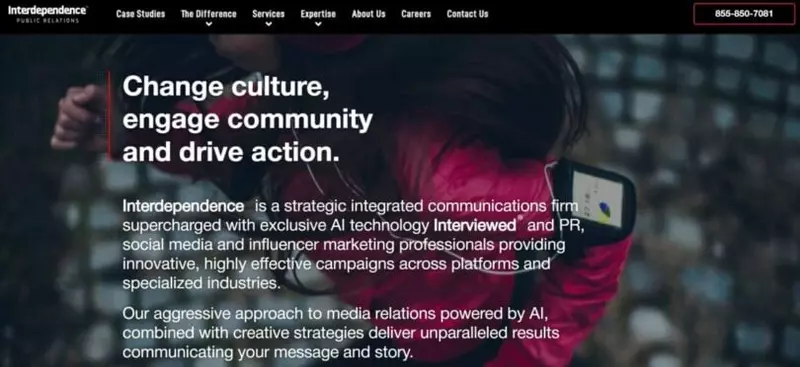
Interdependence™ stands out as a trailblazer in influencer marketing and public relations, offering an unmatched blend of AI-powered precision and human creativity. Central to their approach is their proprietary Interviewed® AI technology, a groundbreaking tool that scours the digital landscape 24/7 to identify trends and opportunities for their clients.
This technology enables Interdependence to craft highly targeted pitches that resonate with journalists and audiences alike, increasing pitch conversion rates by an impressive 300–400%. Their strategic, data-driven storytelling has helped countless brands establish themselves as leaders in their industries while generating tangible results from day one.
Interdependence’s team comprises seasoned PR professionals and media experts with relationships across major publications and outlets. This unique pairing of cutting-edge AI and human expertise ensures every campaign is not only innovative but also deeply impactful, positioning clients as thought leaders in their fields.
Key Services
Interdependence provides a full spectrum of influencer marketing services tailored to drive engagement and build credibility. Unlike traditional agencies, they leverage their proprietary Interviewed® AI to craft multiple story angles daily, ensuring clients achieve maximum media visibility. This sophisticated approach enables the agency to identify the most relevant influencers, create high-quality content, and manage campaigns with unparalleled efficiency.
Their services go beyond the basics, encompassing everything from identifying and vetting influencers to managing content approval and ensuring FTC compliance. They focus on delivering strategies that resonate with both B2B and B2C audiences across various industries, including technology, healthcare, fashion, and real estate. This blend of expertise and innovation ensures that Interdependence consistently outperforms industry standards.
Notable Campaigns
Interdependence partnered with a rising online travel booking service based in Chicago. The client sought to carve out a unique identity in a competitive market, emphasizing personalized customer care and VIP services while driving engagement and conversions across their digital platforms.
Interdependence designed a comprehensive campaign leveraging their Interviewed® AI technology to craft narratives and secure high-profile media placements. By identifying breaking and trending stories relevant to the client’s services, the team developed a series of targeted pitches that highlighted the brand’s unique value proposition and industry leadership.
The campaign also involved boosting the client’s social media presence and engaging social media influencers to amplify their message. Prominent media features in Forbes, Fox Business, CNBC, and the Orlando Business Journal underscored the client’s innovative approach and commitment to customer service excellence.
The campaign delivered exceptional outcomes, generating over one million media impressions within three months. Media coverage significantly enhanced the client’s brand awareness and positioned their leadership team as respected voices in the travel booking industry. Additionally, the campaign drove a remarkable 160% increase in bookings, demonstrating Interdependence’s ability to deliver results that directly impact business growth.
21. Sway Group

Location(s): Sway is an influencer management agency based in Mill Valley, CA.
Sway Group is a 100% self-financed, women-owned company. Indeed, every manager and employee shown on their website is a woman. They offer full-service partnerships to their clients, giving them hands-on strategic service throughout the course of a campaign, with all their work designed to serve big-picture business goals.
They specialize in delivering best-in-class content for their clients. From creative services to influencer activation, every campaign starts with a customized content strategy.
Sway sources influencers who specialize in the subject matter best suited for each campaign, from the fantastic food blogger to the Instagram fashionista. They demand a high level of quality from their content creators, but they also supply them with the resources they need to drive their own engagement and grow their audience.
Each of Sway’s shopper-focused influencer programs has 6-8 dedicated staff members managing daily tasks through completion, including a comprehensive post-campaign report.
Sway has launched its Social Content Studio to bring clients the option of securing compelling brand-owned influencer-driven content. Their skilled in-house creative team can quickly produce either photography or video assets (or both!) as needed.
Key Services/Unique Features:
- Sophisticated social ad strategies
- Network of 30k authenticated influencers
- Quality assurance
22. Station Entertainment

Location(s): Station Entertainment has three offices in Wilmington, Oceanside, and Mexico City.
Station Entertainment is a dynamic influencer marketing agency, specializing in connecting exceptional creators with top-tier brands. The agency represents a diverse range of talents, including influencers, athletes, actors, and media personalities, and is known for its unique, result-oriented approach.
The influencer agency offers services such as influencer representation, brand negotiations, multi-channel growth strategies, monetization strategies, and sponsorships. They pride themselves on building trust-based relationships, advocating for their clients, and securing the best deals on their behalf. Station Entertainment represents a wide array of verticals, from lifestyle and DIY to athletes and gaming.
Their work ethic, characterized by passion and fun, coupled with their dedication to their clients, has earned them high praise from influencers like Home with Stefani, Adalynn’s Lunchbox, and Shannon Detrick.
In essence, Station Entertainment is a partner that believes in its clients’ success, works tirelessly to help them reach their goals, and ensures the journey is enjoyable along the way.
Key Services/Unique Features:
- Influencer matchmaking
- Creative execution
- Dashboard tracking
23. Zorka.Agency

Location(s): Zorka.Agency operates out of an office in Europe.
Zorka.Agency describes itself as being an influencer and performance marketing agency. They offer both influencer marketing services and media buying solutions.
They claim to have combined the best of both worlds—a classic creative agency and a digital technology company.
The digital influencer agency works with influencers to promote products over YouTube, Instagram, Twitter, Telegram, and Twitch. Zorka.Agency will find clients’ audiences in more than 80 countries using a selection of the 350,000 influencers in their database. They use an in-house campaign management platform, Zorka.Video. It combines a database of content creators and a wide range of filters to pinpoint the right influencers for any audience.
Key Services/Unique Features:
- Performance-forecasted strategies
- Brief creation and localization
- Dedicated specialist/team
- Legal and financial supervising
- Advertising execution
- Competitor analysis
24. HYPEFACTORY

Location(s): HypeFactory is a global influencer marketing agency with offices in Cyprus, Serbia, Thailand, Indonesia, Spain, Australia, Hungary, Lithuania, Poland, Israel, Finland, Armenia, China, South Korea, Philippines, and the United States.
HypeFactory operates at the intersection of technology and creativity. They are a one-stop-shop influencer marketing agency that delivers your promotional goals. The agency has created the HypeAuditor tool, which they use to discover the best influencers for their clients. In addition, they use advanced artificial intelligence technologies to select from millions of influencers and find the best fit for your objectives.
HypeFactory uses comprehensive and accurate data to identify influencers best suited for your marketing campaign. They measure Audience Quality Scores, Channel Quality Scores, and many other factors. They apply a wide range of unconventional parameters to find the right audience before taking target action. As a result, they can accurately predict the outcome before a campaign even starts. In turn, the agency shares the results of its campaigns with HypeAuditor to continuously enhance analytic potential.
They adapt their campaigns to use the advantage of each social platform. With Instagram, they recognize the majority of users best interact with colorful and engaging content. So HypeFactory uses stunning images, engaging swipe-up links, as well as paid social and promo codes.
On YouTube, the agency develops intriguing and engaging content to introduce your product. They make sponsored videos, game reviews, pre-roll ads, major worldwide launches, and more.
They recognize that TikTok is the number one platform to run sponsored challenges. HypeFactory creates viral content to engage as many users as possible and applies promo codes. Finally, they see Twitch as the perfect choice to reach gamers and cyber athletes. They see that integrated content in streams can deliver incredible levels of engagement, with up to 30% of the audience engaging directly with ads.
Key Services/Unique Features:
- Influencer marketing audit
- Competitor analysis
- Twitch integration
- Legal support
- Sentiment analysis
- Influencer focus groups
25. HireInfluence

Location(s): HireInfluence operates out of three offices in Houston, Los Angeles, and New York.
HireInfluence is an award-winning full-service influencer marketing agency for the world’s most prominent brands. It has been delivering expert strategies and industry-leading results since 2011. It is a full-service influencer marketing agency, specializing in customized promotional campaigns and consulting.
HireInfluence has become the go-to agency for influencer management among Fortune 1000 brands and top creative agencies across the USA and further afield. They work with a team of influencers across 12 countries and seven industry verticals, to spread their clients’ messages. They share content across most social media channels, using the best channel for each brand. They believe in fully customizing their services around each client’s objectives.
HireInfluence has worked with influencers to document journeys across the Caribbean and Atlantic. Other influencers have become the center attraction at national trade events. HireInfluence’s influencers have even helped to build international exposure for characters like Batman and Scooby Doo.
Key Services/Unique Features:
- All-inclusive content strategies
- Influencer casting and placement
- Event on-site engagement support
- Creative influencer experiences
- Ongoing UGC creation and promotion
- Brand consulting and training services
26. Find Your Influence

Location(s): Scottsdale, AZ
Find Your Influence (FYI) stands out as a premier influencer marketing agency that has been shaping the industry since its inception in 2013. Based in Scottsdale, Arizona, FYI has earned its reputation by offering tailored solutions that cater to the unique needs of brands seeking to build authentic connections with their audiences through influencer marketing.
With years of experience, FYI excels at matching brands with influencers who truly resonate with their target demographics. The agency’s ability to curate campaigns that align with a brand’s core message is what sets it apart. Each campaign is crafted to ensure it not only reaches but also engages the right audience, driving real, measurable results.
FYI’s strength lies in its strategic approach to influencer marketing. The agency offers a blend of creative insights and hands-on support that guides brands through the entire campaign process.
From the initial stages of influencer selection to the final analysis of campaign performance, FYI’s team is there every step of the way, ensuring that each campaign is executed flawlessly. Their ability to track and measure success across multiple platforms further enhances their clients’ ability to refine and optimize their strategies.
The diversity and reach of influencers that FYI works with are impressive, enabling brands to connect with a wide range of audiences. Whether the goal is to drive brand awareness or to promote specific products, FYI ensures that the chosen influencers are the perfect fit for the campaign’s objectives. This careful matching process is a key factor in the agency’s ability to deliver campaigns that feel authentic and generate significant engagement.
Key Services/Unique Features:
- Personalized influencer matching for targeted campaigns
- Comprehensive campaign management from start to finish
- Strategic guidance and creative support throughout the campaign
- In-depth performance analysis and optimization
- Diverse influencer network catering to various demographics and niches
27. NeoReach

Location(s): NeoReach is headquartered in Orlando and operates out of three additional offices in Los Angeles, San Francisco, and Austin.
NeoReach is a reliable influencer marketing agency working with renowned brands like Walmart, Amazon, Airbnb, and The New York Times.
NeoReach influencer campaigns
Along with influencer marketing, NeoReach also offers UGC content creation, market research, and paid media solutions.
With access to more than 3 million influencers, the agency is equipped to work with clients in any industry.
Key Services
NeoReach syncs with your brand to ensure real-time communication that can translate into data-driven and on-point campaigns. The agency collects data from your audience and competitors to formulate effective strategies, reaching your target demographic with the help of influencers.
NeoReach influencer data
It also looks for channel-specific opportunities so that you can use each channel to its full potential. That’s what NeoReach did for Byrna, a non-lethal weapons manufacturer. At the time that this campaign was to be run, TikTok had strict rules about showing weapons. So, NeoReach selected Instagram for the company’s influencer campaign.
The agency specifically looked for influencers who regularly did activities alone, such as travelers and real estate agents. Its experts found 10 micro and mid-tier influencers and got them to post Reels and IG Stories with links to the client’s website. The influencers demonstrated how the products could enhance personal safety and security, making the content relatable and informative.
With just 26 pieces of content, the campaign was able to garner 22k engagements and 331k impressions.
Byrna case study results
With the agency’s platform, finding the right influencers becomes a breeze. You can search for influencers based on their defining attributes, like engagement and audience demographics. The agency’s team will introduce you to influencers and help negotiate the contracts with them.
They’ll then ship the products if you want to run gifting campaigns. Similarly, the agency also maintains ongoing relationships with influencers and takes care of payments. In case you need to activate the same influencers later, NeoReach will facilitate the process.
Success Stories
When Sam’s Club started its limited-time discounted gift cards campaign, the company worked with NeoReach to get the word out. NeoReach activated 15 creators across niches like lifestyle, gaming, crafting, home, and family. Eight of these creators filmed in-store content, while the rest showed online purchases.
Sam’s Club case study
Creators were given creative freedom to choose their favorite brands to showcase, ensuring diverse yet consistent content that aligned with the campaign’s key points. The campaigns were run across TikTok and Instagram, to maximize reach.
By collaborating with creators on both platforms, the agency effectively targeted the desired demographics in family, crafting, home, lifestyle, and gaming niches. NeoReach’s efforts resulted in $202,736 in influencer media value for the brand and 2.5 million total impressions with just 15 posts.
NVIDIA also worked with NeoReach for its back-to-school campaign targeting STEM students with the company’s GeForce RTX 30 Series laptops. NeoReach worked with influencers whose audiences were predominantly students in STEM and data science.
NVIDIA case study
Creators were provided with prompts like “Build Something Awesome” and “Benefits of the Laptop” to guide their content. To resonate with a younger audience, the creators used humor, relatability, and an authentic, upbeat tone in their videos. They demonstrated how the laptop enhanced their computer science and engineering skills, with gaming as a reward for their hard work.
The campaign generated 3.3 million impressions and $266,330 in influencer media value.
28. Cloutboost

Location(s): Cloutboost is a digital influencer agency operating out of Dallas.
Cloutboost is a specialist gaming influencer agency. They promote brands by leveraging the power of YouTube influencers and Twitch streamers.
They offer services at different stages of the influencer marketing process. This begins with influencer targeting and analytics. They use data mining to sift through YouTube and Twitch influencer channels to find the most suitable for their clients’ purposes. Cloutboost looks at a myriad of key drivers like influencer content relevance to the brand, its historical performance, and channel sentiment. From this, they predict trends and Influencer campaign results.
They offer full influencer campaign management, including reaching out, recruiting, and negotiating with Influencers. Their customer success managers are incentivized to maximize campaign performance and grow long-term partnerships with both brands and Influencers.
Cloutboost can also build a large-scale ambassador program to achieve real results. They select and recruit Influencers who prove to be the best fit for the brand. They also develop seamless ambassador program structures and engaging reward systems, while managing the entire program and keeping track of the program’s results in real time.
They help brands and advertisers amplify their campaigns to reach the most relevant, engaged, and effective viewers. On YouTube, they retarget sponsored content viewers across the Google ecosystem, including Google Search. On Twitch, they get their clients’ content recommended in-stream across their network of publishers.
Key Services/Unique Features:
- Influencer geolocation marketing
- Hyper-location implementation
- Influencer content repurposing
- PR management
29. inCast

Location(s): inCast Inc. operates out of two offices in Los Angeles and Sao Paulo.
inCast Inc. specializes in working with influencers, micro-influencers, celebrities and other key contacts across the world. They offer a wide range of services including influencer outreach, content creation, digital marketing, and social media management.
In addition to their extensive experience, inCast Inc. has a team of experts who are well-versed in the latest trends and best practices in influencer marketing. This allows them to create tailored strategies that are designed to achieve your specific goals and objectives.
Also, as an official TikTok partner for content creation, inCast Inc. has access to the world’s most popular social media platform and its more than 500 million active users. This gives them an increased ability to reach your target audience and deliver your message in a way that is both effective and engaging. With inCast Inc., you can be sure that you are working with an agency that is at the forefront of influencer marketing and that is committed to helping you achieve your desired results.
Key Services/Unique Features:
- Influencer marketing campaign management
- Content management
- Real-time performance tracking
- Influencer seeding campaigns
30. Fanbytes by Brainlabs

Fanbytes by Brainlabs is an award-winning social media and influencer marketing agency that helps brands engage Gen Z in the most interactive ways possible.
The agency won ‘Best Large Influencer Marketing Agency’ at the 2022 Influencer Marketing Awards. Their Gen Z marketing experts manage end-to-end influencer campaigns, focusing on that generation’s favorite social networks, TikTok, Snapchat, Instagram, and YouTube.
Fanbytes uses proprietary data, along with its campaign management and social listening tech suite, Bytesights, to deliver scroll-stopping campaigns for significant customers like Burger King, John Lewis, Adidas, Clinique, Vestiaire Collective, Riot Games, Cineworld, McVitie’s, Ubisoft and Ocado. They were the UK Government’s appointed TikTok partner throughout the pandemic, collaborating with them on an award-nominated campaign to keep Gen Z informed and engaged with Covid-related government guidance.
Fanbytes ensures their campaigns drive results at every stage of the influencer marketing funnel. They do this by emphasizing metrics that generate actionable insights, such as clicks, installs, conversions, and brand consideration uplifts, over vanity metrics, like follower numbers, impressions, likes, shares, and comments.
Global digital agency Brainlabs recognized Fanbytes’ potential and acquired them in early 2022. As a result, Fanbytes can now scale your influencer and social campaigns across global territories alongside other paid and organic digital strategies to achieve outstanding results.
31. August United

Location(s): August United operates out of an office in Tempe, AZ.
August United is a full-service influencer marketing agency. They set out to rid the world of boring marketing, and ever since, have been uniting impressive brands with impressive people.
They provide structure to identify influencers, develop campaign concepts, and maintain guardrails to create a sustainable influencer marketing strategy for brands. They also build influencer communities of passionate brand advocates, allowing their clients to leverage influencers for ongoing activations.
One of August United’s unique offerings is organizing influencer brand retreats where clients can meet influencers to set up strategies for their future influencer marketing campaigns.
They include PetSmart, Persil ProClean, Ralphs, and Valley of the Sun United amongst their clients.
Key Services/Unique Features:
- Content creation
- Community engagement
- End-to-end campaign optimization
32. MoreInfluence

Location(s): MoreInfluence has three offices in Eatontown, Los Angeles, and Boston.
MoreInfluence aims to help you drive more sales, attain higher revenue, and have more Influence. They offer 35 years of marketing strategy experience combined with cutting-edge data analytics. In early 2022, MoreInfluence merged with and restructured independent influencer marketing agency Boomopolis.
Their strategy involves using popular influencers to create and distribute engaging branded content across the web, giving their clients brand visibility, awareness, and increased online reach. The two agencies have grown their collective network of influencers and industry experience to create an expanded team with specialized, in-depth influencer marketing knowledge.
Their team of industry-specific social media experts offers each brand a customized solution and unique strategies. They work with influencers on Instagram, YouTube, Facebook, Snapchat, Twitter, TikTok, and other up-and-coming platforms.
MoreInfluence’s data-driven internal analytics process combines with comprehensive external search platforms to ensure you team up with the best influencers to set your brand up for present and future success. They see influencer marketing as a six-step process: Discovery → Proposal → Influencer Approval → Content Approval → Posts Go Live → Data and Reporting.
Key Services/Unique Features:
- Influencer matching
- Influencer relations
- Content guidelines
- Contracting and compliance
- Retargeting and paid social campaigns
33. inBeat Agency

Location(s): inBeat Agency works with a global team through offices in New York, Los Angeles, Montreal, Toronto, Singapore, Paris, Miami, and London.
If you’re looking specifically to work with micro-influencers, be sure to check in with inBeat. They describe themselves as a performance-driven micro-influencer agency, making them an ideal influencer agency for small/large businesses alike.
They work with more than 25,000 micro-influencers on TikTok, YouTube, and Instagram and have helped well-known global brands like New Balance, Nordstrom, and Disney to reach their business goals. In addition to their big network of influencers, you’ll also be able to take advantage of their in-house social media skills and tech.
One of the big benefits of partnering with inBeat is that you’ll also get an in-house creative director assigned to your campaign. Together you’ll come up with a unique angle that will put your content and brand in the spotlight. After all, two heads beat one.
Also, before any collaboration starts, you’ll get to approve the influencers and creators who’ll help you with your marketing campaign. So, if you feel that one of the influencers isn’t a perfect match for your brand and its target audience, you’ll get a say.
Another useful service that they offer is influencer focus groups. So, if you’re not quite ready to launch a campaign yet and would rather just get to know the habits of your customers better, inBeat’s network can help. The groups can also help to generate many more creative ideas that you can use for future influencer marketing campaigns.
Key Services/Unique Features:
- Sponsored direct-response collaborations
- Brainstorming and deploying authentic product placements
- Review generation
- Influencer-centered product sampling campaigns
34. Popcorn Growth

Location(s): Popcorn Growth operates out of an office in Austin.
If you specifically want to zoom in on TikTok, be sure to pop Popcorn Growth a message. They’re a TikTok marketing agency that was founded by minority females, making them a great choice if creating inclusive campaigns is a top priority for your brand.
According to their website, their secret ingredient is the tech that they use. This way, they can fast-track the whole process. Another key ingredient is their data analytics. As they like to put it, it gives their campaigns the “oomph” and lets them optimize campaigns in real time.
The agency’s team of TikTok specialists can help with all the key steps to launching an influencer marketing campaign. Brands like Universal, Kleenex, and Costco Wholesale can vouch for that. For example, when Kleenex reached out to them to help them with an Earth Day campaign, Popcorn Growth managed to generate more than half a million total views.
Key Services/Unique Features:
- Real-time campaign optimization
- Creative video production
- Rapid campaigns
35. Acceleration Partners

Location(s): Acceleration Partners has offices in Boston, London, Berlin, Singapore, and Sydney.
Acceleration Partners has the expertise to help you scale your business with innovative but tailored solutions. They focus on collaborating with you, addressing your needs for each customized campaign they create by providing deep insights in global markets. This allows a more bespoke approach to influencer marketing that considers cultural differences and unique consumer behavior.
As a marketing agency, Acceleration Partners is also well-equipped to deal with the technical aspects of an influencer marketing campaign. They can provide you with access to their platform so you can see all your data in one place. This includes their proprietary data and analytics platform that leverages big data, business intelligence, and predictive modeling to give you insights into your influencer marketing campaigns. With this platform, you can track your progress, optimize your strategies, and make data-driven decisions that will help you achieve desired results.
In recognition of their culture and performance, Acceleration Partners has received several industry awards. Their talented team contributed to these accomplishments, as did their partnerships with the world’s most innovative brands and technology leaders. If you are looking for an influencer agency that is not only experienced but also recognized for their excellence, then Acceleration Partners is the right choice for you.
Key Services/Unique Features:
- Strategic influencer partnerships
- Influencer program management
- Seamless program integration
36. LetsTok

Location(s): LetsTok has offices in Tel Aviv, New York, and Hong Kong.
Leverage the power of AI technology to enhance your TikTok influencer marketing campaigns with LetsTok—the first AdFluencers platform for brands and creators.
Founded in 2020, LetsTok uses proprietary AI-driven tools to help boost your brand and set you up with expert video creators under a wide variety of niches.
With the help of global creators, you’d be able to create campaigns that can push your brand to the forefront. LetsTok connects you with micro- and macro-influencers, allowing you to request for a personal or business video or a video session.
You can use these videos or video sessions in events or simply just have someone to talk to from the comfort of your living room. LetsTok makes interactions with influencers more engaging because it allows the influencers to also see their audience.
Aside from offering services at more affordable prices, LetsTok also helps you measure your campaign performance using KPIs and other important metrics. Note that prices of the services offered can vary from one influencer to another. This is because the talents themselves determine the prices, which you can see reflected on their page and when you’re placing an order.
How long it will take for a talent to fulfill your request can also vary. However, they generally have up to seven days to follow through your requests.
If you’re requesting for a business video for TikTok, for example, you can use it on your website and on your preferred social media platform. It’s worth noting that this type of product has a video rights lifespan of only three months. After which, if you want to extend its use, you’d have to contact the LetsTok team to extend its validity. Furthermore, the LetsTok logo will appear as a watermark in both personal and business videos.
Some of the brands that LetsTok has worked with for TikTok campaigns include telehealth platform Antidote Health and play-to-earn NFT game Time Raiders.
Key Services/Unique Features:
- Brand awareness campaigns
- Performance campaigns
- Brand collaborations
- Automated goal-based influencer selection
37. ApexDrop

Location(s): ApexDrop is headquartered in Erie, PA and has another office in Northwest, PA.
ApexDrop is a North American marketing agency that specializes in building powerful communities of consumers who believe in and support your brand. With over 500 clients, the trust and credibility that the agency has built with both its clients and influencers is unrivaled.
Their affordable services include influencer content creation and distribution, which can be customized according to your budget and needs. You can also take advantage of their management system that makes it easy to keep track of deadlines, payments, and performance metrics.
Not only does ApexDrop have a massive network of influencers at its disposal, but they also have the tools and resources to ensure that your content reaches the right people at the right time. With their cutting-edge technology, they can track data and analytics in real-time so you can see the ROI of your campaigns almost immediately.
Their team of experts will work with you to develop a comprehensive strategy that takes into account your unique goals and objectives. With that said, you can rest assured knowing that your influencer marketing campaigns are in good hands.
Key Services/Unique Features:
- User-generated content
- Monthly content delivery subscriptions
- License-free influencer content
38. Stargazer

Location(s): Stargazer operates out of an office in Miami.
Stargazer was established in 2016 with the goal of providing businesses with an easy and effective way to connect with their target consumers. Since then, they have become one of the leading marketing agencies that specialize in working with influencers. They are not your typical influencer marketing company because they focus not just on creating long-term relationships with their clients but also with the content creators they work with.
When they find social media talent they believe in, whether in a niche community or with a large following, they invest in them and help them grow their personal brand. This allows you to tap into new markets and reach consumers that you wouldn’t be able to reach through traditional marketing channels.
Stargazer is distinguished by its team of marketing experts who are well-versed in the latest trends and best practices in influencer marketing. Consequently, they can develop strategies that are tailored to meet your specific needs and objectives. In addition, they offer a wide range of services including influencer outreach, content creation, digital marketing, and social media management.
Even with the latest trends when it comes to marketing, Stargazer believes that it is more important to have a smaller group of high-quality influencers than a large group of mediocre ones. If you decide on partnering with Stargazer, you can be confident that you are working with an agency that provides you with the best possible results that will drive conversion and ROI.
Key Services/Unique Features:
- User-generated content
- TikTok advertising
- TikTok account management
- Focus on long-tail influencers
39. The Outloud Group

Location(s): The Outloud Group operates out of an office in Detroit.
The Outloud Group is a full-service influencer marketing agency that creates and executes strategic campaigns to deliver measurable results at scale. They partner with brands and influencers to deliver highly effective and authentic marketing campaigns.
They don’t restrict themselves to just midwestern clients, however. They also work with clients in Los Angeles, New York, and abroad. They have worked with brands on influencer campaigns since 2008.
The Outloud Group’s bread and butter is direct response ads. Brands are involved in crafting the message, but creative control ultimately rests with the influencers to ensure authenticity. The company also helps with campaigns involving branded content, using suitable influencers and their captive audience.
The Outloud Group also works with the other half of the influencer equation. They provide talent representation services to quality influencers. They bring brand campaigns to influencers they know, like, and trust.
Key Services/Unique Features:
- Campaign logistics
- Influencer paid social campaigns
- Gaming influencer marketing
40. Go Fish Digital

Location(s): Go Fish Digital has offices in Raleigh, NC and Arlington, VA.
Go Fish Digital is an 18-year-old digital marketing agency offering a wide range of digital marketing services, including search engine optimization, online reputation management, web design and development, search engine marketing, conversion rate optimization, and content marketing. Most importantly, in terms of this list, they also offer influencer marketing services.
The company consists of a team of technical marketers and creative thinkers helping companies attract more attention online, build more traffic to websites, improve their reputations, and obtain more conversions.
Although Go Fish Digital works with some of the largest brands, franchises, and CEOs, they also help fast-growing small and medium-sized businesses with their digital marketing needs. Everything they do is driven around what it will take to help their clients reach their goals.
Go Fish Digital’s influencer marketing agency has worked tirelessly to form and grow ongoing authentic relationships with influencers across a variety of niches. Their network of social influencers has developed engaged communities that trust their recommendations and opinions. Each influencer campaign is unique and personalized for both the brand and the tone of voice of the influencer.
Key Services/Unique Features:
- Paid media advertising
- Digital PR
- Social media management
41. Navigate

Location(s): Navigate operates out of its office in Bristol.
Navigate is a British agency involved with social media marketing, strategy, and influencer PR. They specialize in creating digital campaigns for brands, using social media to get brands noticed.
They recognize the power of social media to amplify a brand’s voice, and that influencers are in a powerful position to help with this. Navigate works with a network of UK bloggers, vloggers, Instagrammers and Pinners as social influencers to amplify brand stories to the most suitable audiences.
They cover the full service for brands, providing a service for them from strategy to the influencer-based delivery.
Key Services/Unique Features:
- Travel and conservation marketing
- Dynamic creative
- Conversion retargeting
- Influencer paid media campaigns
42. MikeWorldWide (Previously Everywhere Agency)

Location(s): MikeWorldWide is headquartered in New York and has additional offices in Los Angeles, London, Washington DC, New Jersey, Chicago, and Denver.
What was once a dedicated influencer marketing agency, Everywhere Agency was acquired by MikeWorldWide in 2020. MikeWorldWide calls itself a people-first public relations firm with influencer marketing being only a small part of an array of offerings.
The agency offers a range of consumer brand marketing services, often leveraging the power of influencers for content distribution. Besides their influencer marketing services, they also offer services in corporate reputation management and creative development among many others.
Key Services/Unique Features:
- Strategic partner promotions
- Product launch promotions
- Research and analytics
43. Monks (formerly IMA)

Location(s): IMA has its global headquarters in Amsterdam and operates out of six other offices in Los Angeles, New York, London, Singapore, São Paulo, and Shanghai.
IMA makes its purpose very clear in its name. They claim to be the leading agency for digital influencer marketing. They are full service, taking a campaign from defining goals and objectives through to completing the campaign execution.
They operate a network of more than 12,000 influencers, who, according to IMA’s website, have a combined social following of 6.9 billion people – although there must obviously be some duplication of followers, considering the entire world population is not much greater than 7.6 billion. Actually, the website makes the dubious statement that their influencers have a combined reach of over 6 trillion consumers, which has to be considered a case of poetic license, with the Population Reference Bureau estimating that about 107 billion people have ever lived.
IMA has a strong client roster including Diesel, Nivea, Timex, Samsung, TomTom, and Calvin Klein.
Key Services/Unique Features:
- Talent relations
- Contracting
- Content guidelines
- On-site event management
- Quality assurance
- Paid social
- Content management
44. INF Influencer Agency

Location(s): INF Influencer Agency is based in Vancouver.
INF Influencer Agency is a Canadian agency, that recognizes the importance of influencer marketing, and has made it a business focus. They work in partnership with The Feldman Agency, a North music management group with over 40 years in the entertainment business, who handles artist representation, talent management and booking, event services and corporate consulting.
INF is more of an influencer management agency than an advertising agency, in many ways working like a talent agent. They help to grow their influencers’ personal brands, develop opportunities and manage offers. This makes them an ideal agency for influencer management with the capability to connect brands with influencers who match their core values.
Key Services/Unique Features:
- Brand ambassador programs
- Content creation
- Product placement
- Digital, print, and on-camera campaigns
- Curated collections
- Organizing speaking engagements and appearances
45. Jin

Location(s): Jin is a European agency with offices in Paris, London, Lyon, Berlin, and New York.
Jin describes themselves as a Digital PR and Influence agency. They offer services in inbound marketing, reputation management, influencer marketing, and providing insights.
Jin uses proprietary influencer discovery software called Plugr to help brands find the most suitable influencers for their audience. Plugr analyses conversations and media in real time to provide clients with consumer insights. One of its features is influencer mapping, where it maps the main digital influencers on a certain subject or brand, to understand who and what is shaping public opinion.
Jin includes Bic, eBay, Ricoh and Roche as clients.
Key Services/Unique Features:
- Social commerce
- Social listening
- Content creation
- Communities audit
- Crisis monitoring
46. Passion Digital

Location(s): Passion Digital is a UK-based agency with an office in London.
Passion Digital offers a wide range of digital services, including PPC (Pay Per Click), SEO, Social Media Services, and Web Design and Development.
Their social media offering also includes influencer marketing services. Passion Digital has access to a broad network of influencers to work with brands in spreading their message. They also use their digital research and social monitoring tools to find other suitable influencers. They then help their clients by managing their campaigns, using the bloggers, vloggers, Instagrammers, and celebrities of their clients’ choice.
Key Services/Unique Features:
- Research and insight
- Strategy and planning
- Social media management
- Social media advertising
47. Pulse Advertising

Location(s): Pulse Advertising is a Europe-based digital influencer agency with offices in Hamburg, London, Milan, New York, Berlin, and Paris.
Pulse explains their name as being a result of them being at the pulse of social media. As with most of the specialist influencer marketing agencies, they have a network of influencers who they can call to assist in spreading their brands’ messages.
Pulse breaks its services down into Brand Awareness, Brand Positioning, Market Entry, Product Launch, and Social Strategy. Similarly, they break their process into steps: Social Strategy, Kickoff, Campaign Concept, Influencer Selection, Content Creation, and Reporting.
They can claim quite a few high-profile names amongst their clients, including Unilever, Daimler, Adidas, Puma, Gillette, Huawei, and Swatch.
Key Services/Unique Features:
- Strategic consulting
- Native influencer ads
- Retargeting campaigns
- Brand audit
- Content production
- Community management
48. Redpill

Location(s): Redpill is a leading influencer marketing company based in London.
“You take the blue pill, the story ends. You wake up in your bed and believe whatever you want to believe. You take the red pill, you stay in Wonderland, and I show you how deep the rabbit-hole goes.”
The above quote comes from The Matrix and takes its meaning from popular culture where the red pill represents knowledge, freedom and the sometimes painful truth of reality. (Redpill clearly believes that they provide consumers with campaigns that enliven them and open their minds, rather than brainwashing them.
With clients like Coca-Cola, Jaguar, Samsung, and Heineken, they have clearly produced results to attract the big brands.
Redpill’s clients have access to their in-house selection tool that recognizes more than 26,000 influencers across YouTube, Facebook, Twitter, Instagram, and Snapchat. Redpill has a strong creative team to help produce material for the influencers to share. They began as a production company in the early days of YouTube and grew into a full-service production house and content marketing agency.
Redpill works with over 70,000 publishers, vloggers and social influencers across 57 territories, amassing a combined reach of 3.7 billion people.
Key Services/Unique Features:
- Paid promotion
- Performance strategies
- Omni-channel strategy
- Paid media campaigns
49. Rosewood

Location(s): Rosewood Creative operates out of an office in Afghanistan.
Rosewood Creative believe themselves as being the new generation of social media marketing. They provide services for brands in the areas of social media management, content production, and influencer marketing, often mixing up all three streams for any particular campaign.
Rosewood calls themselves “…a collective of creative and passionate storytellers who craft premium, authentic, and strategic social media narratives that drive emotional connections with consumers, resulting in social shareability.” They develop strategies and content and influencer campaigns for quite a few big-name clients, including Apple, Sony Pictures, Nike, Red Bull, Dr Dre, Lady Gaga, and Toyota.
Key Services/Unique Features:
- Audience and subculture insights
- Culture trends
- Creative ideation
- Creative direction
- Creator and influencer playbook
- Creator management
50. Stryde

Location(s): Stryde is an audience focused eCommerce digital marketing agency, based in Salt Lake City, Utah.
Stryde works with eCommerce businesses ranging from startups to enterprise sites. Their list of services includes content marketing, SEO, PPC, social media, and influencer marketing. They believe that success isn’t built on one of these areas alone, but that each of the components works to support and feed the others.
This means, for instance, that that may well build up a content strategy and create content as part of their content marketing, optimize it as part of their SEO services, and put together a social media strategy, which includes distributing it via influencer marketing.
They offer a range of influencer marketing services including Influencer Identification and Selection, Campaign Creation and Execution, Influencer Outreach, and Performance Tracking. They work with influencers on Facebook, Instagram, and Blogger.
Key Services/Unique Features:
- Paid social campaigns
- Brand audit
- Messaging strategy
- Competitive analysis
51. Team Epiphany

Location(s): Team Epiphany is an influencer agency based in New York with an additional office in Los Angeles.
Team Epiphany’s website certainly gives an eye-catching first impression of their work. This social media influencer agency has managed to snare quite a few big-name clients in almost two decades of operation. These include Moet & Chandon, Heineken, Cadillac, HPNOTIQ, Nike, Hennessy, JBL, HBO, and Tanqueray.
They describe themselves as creating specialized marketing poised for mass adoption and are about amplifying influence and leveraging the networks that create it. Their areas of focus are Creative Services, Brand Strategy, Experiential (things like special events and pop-ups), Social Media, Influencer Engagement, and Public Relations.
One example of their influencer marketing was for Cadillac. In recognition that luxury nowadays tends to be subtle, rather than flashy, Team Epiphany wanted their luxury Cadillac promotion to appear to be aimed at “the select few”. Hence, they utilized influencers who appealed to those “select few”, for example, fashion influencers.
They also wanted to ensure that this emphasized the modern new world and ensured that they used a genuinely multicultural selection of influencers. For New York Auto Week, Team Epiphany highlighted Cadillac’s ELR – an upscale electrified coupe – by utilizing four highly-influential photographers—Liz Eswein, DJ D-Nice, Jonathan Mannion, and 13th Witness to document a week with the car.
Key Services/Unique Features:
- Progressive multi-cultural marketing
- Influencer integration
- Influencer amplification
52. TopRank Marketing

Location(s): TopRank Marketing operates out of an office in Minneapolis.
Compared to many of the agencies listed here, TopRank Marketing is positively ancient, having been established in 2001. They are a digital marketing agency, with a large emphasis on B2B companies, although they do work for B2C companies as well. Their clients range from funded start-ups to Fortune 50 brands.
They use what they call the Optimize 360 Model as their marketing approach – which is basically Attract, Engage and Convert. They place their digital marketing services into the following categories: Content Marketing, Search Engine Optimization, Social Media Marketing, Influencer Marketing, Digital Advertising, and Website Analytics & Conversion Optimization.
In terms of influencer marketing, they believe the key to ROI for brand and influencer relationships is content. They believe that by brands collaborating with influencers over content things can be mutually beneficial.
Key Services/Unique Features:
- Integrated influencer marketing strategy
- Content development with leading industry influencers
- Influencer identification, recruiting, and outreach
- Full influencer marketing program implementation
- Influencer content amplification
53. Billion Dollar Boy

Location(s): Billion Dollar Boy is a global influencer agency working out of offices in London, New York, and New Orleans.
Billion Dollar Boy is a hyper-caffeinated transatlantic creative agency. The company actively creates campaigns across seven continents with top brands spanning categories of beauty, fashion, retail, lifestyle, consumer goods, food and beverage, and automotive. The team is harnessing the power of influencers to win hearts, catch eyes, and reinvent advertising as we know it.
Their creative strategists work with brands to choose suitable influencers who will develop creative ideas for campaigns, and they also work with the influencers to decide on the optimal distribution strategies. Billion Dollar Boy believes in equality, diversity, and inclusivity in influencer marketing. They use their software, Companion to determine the best influencer fit for any campaign and partner with Nielsen to do brand studies measuring uplift.
Key Services/Unique Features:
- Paid media amplification
- Content development
- Long-term ambassador programs
- Strategic gifting
- Custom activations
- Experiential campaigns
54. Ykone

Location(s): Ykone is a truly global influencer agency headquartered in Paris with additional offices in Milan, Berlin, Munich, Geneva, Miami, Las Vegas, Hong Kong, Shanghai, Singapore, Dubai, Abu Dhabi, Riyadh, Jeddah, Tunis, and Bangalore.
Ykone is an international creative agency for digital content and influencer marketing, with an emphasis on fashion, luxury, and beauty brands.
They develop influencer campaigns for well-known brands, such as L’Oreal Paris, Dior, Swarovski, and Marc Jacobs.
They use their proprietary software, Campaygn, to analyze the audience and universe of more than 50,000 influencers, with 1.2 billion followers, in real time. Ykone then adds additional information to the database for the top 5,000 influencers manually.
The company was founded by Olivier Billon in 2008 and claims to be the first influencer marketing agency. The “Y” in the company’s name represents Generation Y, who were the young adults finding a love of fashion, luxury, and beauty at the time Ykone was created.
Key Services/Unique Features:
- Strategic audits
- Co-creation
- Forecasting
- Competitive benchmarking
- Art direction
- Trend reporting
- Influencer briefing
- Creative production
- Concept and copywriting
55. Upfluence Inc.

Location(s): Upfluence Inc. operates out of offices in New York, Los Angeles, Lyon, and Mexico City.
Although Upfluence is probably best known for its influencer marketing platform, it also acts as an agency that connects influencers with brands. While a dedicated team of influence experts manages your campaign, Upfluence provides its agency clients with full software access to have 100% transparency on the progress.
It finds the perfect content creators where your audiences overlap: Instagram, TikTok, Twitch, YouTube, Blog.
Upfluence is also happy to assist with influencer event management. Its content creators can match the needs of your client for any special events. Upfluence prevents no-shows by entering into long-term agreements with their influencers. They offer on-site tracking and host management.
Some of the steps that Upfluence takes in its influencer agency role include:
- Discovery call – learning about client needs
- Strategy design & ideation – setting up a solid plan
- Campaign kick-off – agenda, emails, dashboards
- Content creator’s curation – reaching out to content creators to create high-quality content through influencer marketing
- Brief endorsement – highly detailed with content guidance
- Influencer marketing and partner relationship management – ensuring smooth communication and high response rates
- Content creators onboarding – signing agreements
- Influencer generated content – with drafting and approval from both Upfluence and the client
- Influencer payment – making sure that the influencers met the expected content guidelines before they pay them
- Reporting and recommendation
Key Services/Unique Features:
- Multi-currency payment management
- Promo code generation
- Sales tracking
56. SugarFree

Location(s): SugarFree is based in New York, Costa Mesa, CA and San Diego, CA.
SugarFree is a diverse group of marketing professionals, social media gurus, talented creators, and data analysts, all working together with their clients to create a truly seamless experience.
Their strategies focus on telling a story that lives on well after a campaign is over. They infuse clients’ core messaging into all aspects of the campaigns they create. SugarFree find influencers who fit in with a client’s aesthetic and culture, distributing content to relevant audiences.
Over time, the agency has built a vast network of the best creators whose trust they have earned over time. It means that they work with fully vetted influencers and bloggers with a proven track record of success across traditional, digital, and social media. They also handle all the coordination of content deliverables with influencers, keeping campaigns on-time and on-budget.
They schedule every post and then stay on top of a campaign as it progresses. Their influencers don’t just post and collect their paychecks. They act as ambassadors, staying engaged with their audience and keeping their content fresh and relevant.
SugarFree provides detailed reports that focus on the metrics that matter most to their clients while scrutinizing performance on an individual level.
Key Services/Unique Features:
- Strategy direction
- Price negotiations
- Legal contracts
- Compliance and payments
57. Veritone One

Location(s): Veritone One operates out of an office in Denver.
Veritone One is a full-service advertising agency incorporating podcast, radio, digital, TV, and analytics. They also claim to be the world’s largest performance audio agency. Importantly, they also act as a YouTube influencer marketing agency. They claim to be the industry leader in performance-based YouTube influencer marketing.
The agency uses a proprietary discovery platform and valuable partner relationships to pair you with the right talent for the maximum return on investment.
Veritone One is powered by Veritone aiWare. This is a proprietary platform that processes and organizes unstructured audio and video data using AI-based cognitive computing. The technology helps the company collect real-time actionable intelligence to better optimize your media and brand’s messaging to improve your campaign’s performance.
Key Services/Unique Features:
- Cross-platform strategy
- Podcast advertising
- Hyper-targeting
- 360-activation
- Product distribution
- Content approvals
58. Post for Rent

Location(s): Post For Rent has six offices in Amsterdam, Budapest, Zagreb, Athens, Sisli, and Karachi City.
Post For Rent offers a collection of solutions to cater to all your influencer marketing needs. You can either use it as an influencer platform, searching through its extensive database of influencers, or let the company handle everything for you.
If you opt for Post For Rent’s managed services, all you have to do is set your campaign objectives. They deliver you a plan that matches your brand values and tone of voice. They give you a dedicated campaign expert, prepare a competitor analysis, and come up with estimated results.
Through analysis of audience interests, behaviors, and more, Post for Rent filters, analyzes, contacts, and contracts the most suitable influencers for your campaign. Once you have a team of influencers, it’s time to put your influencer marketing into practice. The digital influencer agency handles all content, from formulating the original concepts to full content production and optimization.
Post For Rent’s reports give clear insights into the ROI your campaigns have generated. They even provide detailed information on each piece of content posted by your influencers.
Key Services/Unique Features:
- Influencer profile analysis
- Relationship management
- Contracts and payments

Key Features: Search/Discovery, Influencer Relationship Management, Team Collaboration Tools, Content Review, Campaign Management, Campaign Reporting, Influencer Analysis, Audience Analysis, Forms and Compliance, Payment Processing, Client Relationship Management,
Channels: Facebook, Instagram, Twitter, YouTube, TikTok, Blogs, Snapchat
59. Top Influencer Marketing Agencies in 2025

UK-based EngageHub considers itself a socially led influencer marketing agency that will take your product to market and influence the “new” generation. They offer brands a range of marketing options to reach out to busy target customers. They can assist with influencer marketing, creative & production, paid media, social commerce, and social media management.
They describe themselves as product-led creatives who plug into your brand to send your commercial, social, creative, and influencer marketing sky-high.
EngageHub delivers a full-service, integrated approach to influencer marketing, meaning they cover all the elements needed to provide campaigns that turbocharge your commercial goals. They ensure you spend your budget for maximum reach and ROI. The agency pairs your brand with influencers that will deliver maximum results, including nano, micro, and mid-level influencers with highly engaged audiences.
They work with influencers across all the popular social networks, including Instagram, Facebook, YouTube, TikTok, Twitch, Twitter, LinkedIn, and Snapchat, meaning that they should find suitable influencers for you, no matter what market you target.
60. MG EMPOWER

Location(s): MG Empower is a global integrated marketing agency based in London.
MG Empower is a global influencer marketing agency that empowers brands to go #AboveAndBeyond. They help brands grow their businesses, reach new audiences, and make an impact with digital and influencer marketing.
The influencer marketing company believes in the power of people to drive business value through social, experiential, and innovation. They take a 360-degree approach to brand storytelling and co-creation with the goal to achieve greater ROI.
Key Services/Unique Features:
- Network of 3+ million influencers
- Content production
- Paid media campaigns
- Creative direction
- Channel optimization
- AI-powered proprietary software
61. Socially Powerful

Location(s): Socially Powerful serves an international clientele from offices in Dubai, Beijing, New York, and London.
Socially Powerful is one of the leading international influencer marketing agencies. They offer bespoke end-to-end social media influencer marketing services that merge the power of humanity and technology.
To ensure that their campaigns perform exceptionally, they pay extra special attention to platform as well as influencer selection. In addition to working on the major platforms like Instagram, TikTok, and YouTube, they can also activate campaigns for WeChat and Weibo.
Their team of social experts (or social scientists as they like to call them) boasts in-depth knowledge of all things social by staying up to speed with social and cultural trends. This means that whatever they create will be relevant.
Whether you need help with a one-off campaign or you’re more interested in a long-term collaboration, they’re happy to share their expertise. As a matter of fact, if they can’t help you to reach the agreed-upon KPIs, consider the service that they’ve rendered free of charge.
Key Services/Unique Features:
- Paid media amplification
- Content strategy
- Proprietary influencer technology
What Makes a Top Influencer Marketing Agency?
There are several factors that distinguish a high-end influencer marketing agency from its average counterparts. Here are some of them.
Network of Quality Influencers
A top influencer marketing agency should have a large and diverse network of quality influencers across different social media platforms and verticals. These influencers should have a substantial following, high engagement rates, and a strong reputation within their respective niches. The agency should also be able to provide data and insights on the target audience of these influencers to ensure they align with the brand's target demographic.
Take NeoReach as an example. They have over 3M influencers across various verticals. Even better, they provide in-house services to their influencers that help them produce high-quality content consistently.
Strategic Expertise
The top influencer marketing agencies possess strategic expertise in developing tailored campaigns for their clients. They are also familiar with social media algorithms, industry insights, platform-specific best practices, and influencer marketing trends, which they account for when running influencer marketing campaigns.
Multi-Platform Creative Capabilities
Now that an average customer is present on multiple social media platforms, brands have to run influencer campaigns across more than one platform. The cream of the crop influencer marketing agencies understand this requirement.
That's why they specialize in running campaigns on all major social media platforms, particularly the visual-centric ones like Instagram, TikTok, and YouTube.
ROI Measurement and Analytics
The best influencer marketing agencies in the market don't merely rely on their word. They deliver trackable results and even provide regular analytics for all campaigns they run. Many of them use influencer analytics tools to show third-party, unbiased data from their campaigns.
In addition to all this, influencer marketing agencies help influencers and creators create media kits. These are resources that brands use to acquire more information about their influencer when getting into collaboration with the influencer.
What are the Benefits of Partnering with an Influencer Marketing Agency?
For any business, big or small, partnering with an influencer marketing agency can be quite beneficial. Here's why.
Access to Industry Expertise
While influencer marketing isn't exactly a novel approach, it's still comparatively new, and many brands are just getting started. Your in-house team may not be fully proficient in handling influencer campaigns. An influencer marketing agency has sufficient expertise to develop comprehensive, result-yielding campaigns.
Time Efficiency
Identifying influencers, negotiating rates, sending PR packages, creating content, and managing influencer relationships take a lot of time that you may not have. The time constraints are more pronounced for small businesses with limited human resources and enterprises that need to run multiple campaigns simultaneously.
With an influencer marketing agency on board, your influencer campaigns can work in tandem with other marketing activities without requiring a chunk of your time.
Access to Influencer Networks
Since influencer marketing agencies already have a roster of influencers they have previously worked with, they can easily reach out to them for your campaign. For a brand to do this, it would take a lot of time and resources since creator relationships don't forge overnight.
Easy Influencer Management
When you work with an influencer marketing agency, you don't have to worry about finding the right influencers, getting legal rights for content use, managing contracts, and ensuring timely payments. The agency will handle all this from start to finish.
Some agencies also have proprietary platforms you can use. For example, NeoReach's tool lets you find influencers and then manage everything from payment and content delivery to product gifting in the same place.
Data-Driven Decision-Making
Influencer marketing agencies focus on extracting insights from campaign data and then using them for decision-making. Many of them use AI in data analysis to further improve campaigns. Data-backed decisions not only bring forth desirable results for influencer campaigns but also save money and time in the long run.
How Do Influencer Marketing Agencies Charge Their Clients?
Digital marketing agencies' pricing models range from retainers to project-based. The same applies to influencer marketing agencies. Here are the most common pricing structures you'll find:
- Retainer Model: In this pricing structure, you pay a fixed amount to the agency every month, quarter, or year for a set of services. Go for this model if you plan to work with the agency for the long term. Monthly retainers can range between $5,000 and $250,000, depending on the type of influencers you want to work with. For macro and mega influencers, the cost is on the higher side.
- Hourly Rate: Although less common, some agencies charge an hourly rate for their services, such as strategy sessions or consulting. This is suitable for short-term projects or when you need a specific task completed. On average, you can expect to pay between $25 and $50 per hour, but pricing can be as high as $100 per hour.
- Campaign-Based Pricing: Some agencies charge a one-time fee for each campaign. They give a custom quote based on the scope and requirements of the campaign. It's a flexible payment model that clients can tweak based on their budget and objectives. For a smaller campaign with nano-influencers, you may pay less than $1,000. For larger campaigns with multiple influencers and platforms, expect to pay upwards of $20,000.
- Performance-Based Pricing: Another less common pricing model is performance-based, where the agency receives a percentage of the campaign's success. They base the "success" on pre-selected metrics, such as sales generated from the campaign. It's a high-risk, high-reward model, and not all agencies offer it. Suppose you agree on a 5% performance-based fee for a campaign that generates $100,000 in sales. The agency receives $5,000.
- Markup Based: Agencies with this pricing structure add a markup fee (usually 20-30%) on top of the influencer's rate. This model is more common in talent management agencies, where the agency represents and manages the influencers' partnerships. For example, for a sponsored Instagram post with an influencer charging $500, the agency would add their 20% markup fee, making the total cost for the client $600.
Apart from these pricing structures, some agencies may have a hybrid model. For example, you may have a monthly retainer, but any additional campaigns or services are charged at an hourly rate. Suppose your monthly retainer is $3,000 for one campaign with three micro-influencers per month. If you want the agency to run ads on influencer-generated content, those charges will be on top of the $3,000 you pay.
Conclusion
For brands that don't have dedicated influencer management departments in their social media teams or those that want to enhance their digital presence, influencer marketing agencies can be the best bet. Often, brands hesitate to work with agencies due to price points.
But there are many agencies on our list that provide services to businesses of all sizes. Working with such an agency can bring a fresh perspective to your social media strategy.
Also, their expertise in the influencer marketing space can help you get the results that you won't otherwise achieve. So, it's worth investing in an influencer marketing agency to give your brand a competitive edge.
Frequently Asked Questions
What does an influencer marketing agency do?
An influencer marketing agency acts as a middleman during the influencer marketing process. Many influencer marketing agencies are full-service and can assist brands through all the stages of the influencer marketing process. This means they can help them with influencer discovery, influencer management, content creation, and analyzing and reporting on the success of a campaign.
Is there an influencer marketing agency that specializes in gaming?
You can check out Cloutboost. It is a specialist gaming influencer agency that markets brands by taking advantage of the power or Twitch streamers and YouTube influencers. Their services include contacting, recruiting and negotiating with influencers; creating large-scale ambassador programs and predicting trends.
What are the best influencer marketing agencies in New York?
You can try NewGen, Obviously, Open Influence, The Outland Group, and Team Epiphany. These are some of the leading influencer marketing agencies with offices in New York. NewGen, Obviously, The Outland Group and Open Influence are full-service creative influencer marketing agencies, while Team Epiphany specializes in creative services, brand strategy, influencer engagement and public relations.
What are the top influencer marketing agencies in Europe?
You can check out Zorka, Jin, Passion Digital and Ykone. These are some of the leading influencer marketing agencies with offices across Europe. Zorka's HQ is located in Cyprus, and they also have offices in Poland, and Lithuania. Jin and Ykone have offices in Paris and Germany, while Passion Digital operates in Spain. In addition to influencer marketing, these agencies also offer other digital services that include reputation management, media buying services, web design and pay per click.
Should you work with an influencer marketing agency?
If you find the process of discovering influencers, contacting them, picking the most appropriate ones and running campaigns with your chosen influencers takes too much time, it is a good idea to work with an influencer marketing agency. Many influencer marketing agencies are full-service, in other words they can help brands with every stage of the influencer marketing process. Agencies have been part of marketing for many years and can offer valuable services.
What are the best influencer marketing agencies for different business objectives?
While all influencer marketing agencies fulfill the same purpose, some may be better suited for specific business objectives. These agencies either have expertise in a particular niche or offer unique services that align with certain objectives. Here are some examples:
- Best Fashion Influencer Marketing Agencies
- Best Gaming Influencer Marketing Agencies
- Top Multicultural Influencer Marketing Agencies
- Top YouTube Influencer Marketing Agencies
- Best Global Influencer Marketing Agencies
- Top Beauty Influencer Marketing Agencies
- Top Micro-Influencer Marketing Agencies
- Leading LinkedIn Influencer Marketing Agencies




